Types of water meters: overview of various types + recommendations for customers
The volumes of water use established by the standards are noticeably overestimated. They are much more than its real expense. With the increase in water tariffs, the issue of economy becomes relevant. Something can be saved only if consumption is kept.
To pay less, you need to install a water meter. But there are so many varieties of this device that it can be difficult to navigate when choosing. You do not know how the types of water meters, presented in assortment by different manufacturers, differ among themselves? We will help to deal with this issue.
The article considers the types of water meters, their features and the principle of operation. Photos and video recommendations are listed, the rules for choosing the best option for use at home are listed. Based on our advice, buying an meter will be extremely easy.
The content of the article:
Existing types of water meters
The correct choice of a device for controlling consumed water cannot be made without knowledge of the characteristics of different types.
Based on the principles of operation of the devices, the following types of water meters are distinguished:
- tachometric;
- vortex;
- electromagnetic;
- ultrasound.
The design of each species has its own characteristics. Let's consider everything in detail.
Features of tachometer counters
This type of water meter is the most common. They function according to a simple principle.
Positive and negative characteristics
Mechanical water meters are compact. You can mount them in remote places, so they do not spoil the interior of the room. The simplicity of design allows you to set the price acceptable for most consumers on these devices. The error of their testimony is negligible.
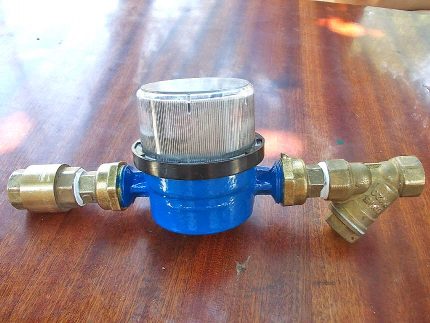
The following characteristics are negative:
- wear of the blades;
- sensitivity to impurities present in water;
- the dependence of the readings of the water meter on the magnetic field;
- inability to record instantaneous flow;
- the presence of moving elements in the flow chamber.
Despite the presence of shortcomings, if you follow the calibration schedule, the meter can last up to 12 years. For the operation of the device does not need external sources of power supply.
Principle of Operation and Design
The main element of the counter is the impeller. It has a perpendicular orientation of its axis with respect to the direction of the water supply. The diameter of the nominal passage of this type of device does not exceed 50 mm.
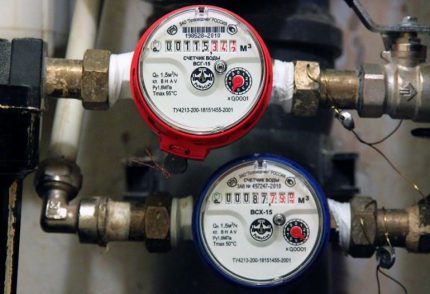
When an avalanche of water in transit passes through the impeller, movement in a circle occurs. Each is accompanied by an overflow of a certain amount of liquid through the device. The greater the pressure created by water, the faster the impeller spins.
A sensitive counting mechanism through the gearbox receives information about the number of revolutions, and all changes are shown by the dial.
Devices with an impeller are single-jet, multi-jet, combined. First, water is supplied to the input blades by one stream. A torsional shock is sent to the indicator of the counting unit by a magnetic coupling. Experts advise installing such meters on hot water pipelines with a cross section of 15 to 30 mm.
In multi-jet models, the flow on the way to the impeller is broken into parts. The measurement error decreases, because there is an impact on the blades of equal strength. In this case, flow turbulence is completely eliminated.
Designed device for mounting on pipes with cold water with a diameter of maximum 50 mm. Such a water meter is ergonomic, it is easy to install and dismantle if you need to perform verification.
When the scope of water use measurements needs to be expanded, a tachometric device of a combined type is installed. It is understood that with a change in the flow rate, a single counter comes into operation. A transition occurs automatically.
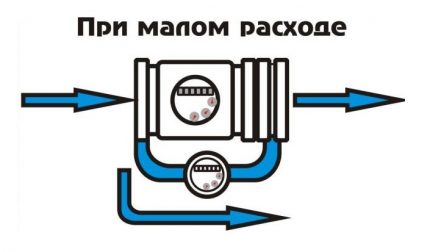
There is only one measuring unit, it has high accuracy, is tight, therefore it works even in flooding conditions. For Du pipes more than 50 mm, instead of an impeller, a rotating turbine is laid in the design of the device. The water meter in this case is installed along the axis of the highway. The ideal place to install it is at the entrance.
Such meters are mounted on pipelines of industrial enterprises with a cross-section of up to 500 mm where significant volumes of water pass. The direction and angle of the flow are determined by a special fairing.
Dry and wet-going devices
Based on the location of the counting device, the tachometric water meters are divided into dry and wet. In the first case, the liquid does not affect the counting mechanism. The rotational movement from the impeller is communicated to him by means of a special magnetic coupling.
The mechanism is protected from corrosion by an impermeable partition. The model has a fairly high cost, but it can be used even where hot water is supplied, in which there are large amounts of impurities.
In addition, the accuracy of the readings of such a device is very high. If there is a need for remote data acquisition, a pulse output device can be included in the system.
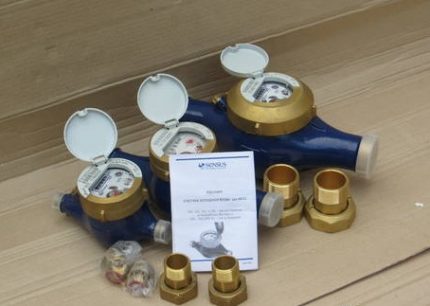
The module collecting information can be located at any distance from the measurement node.
In a wet-going device, the metering unit is in constant contact with a dirty liquid. This adversely affects the duration of his service. To correct the situation, a filter is mounted in front of the counter.
Electromagnetic water meters
This type of appliance cannot do its job without electricity. The basis of its functioning is the ability of water to pass an electric current.
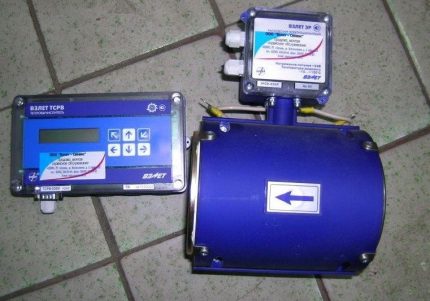
When a fluid overcomes a magnetic field obtained artificially, it changes its parameters, sensors record this, and the data appears on the display. This is an expensive type of meter. It serves well and for a long time if the pipes are free of scale. Since such conditions are rare, electromagnetic devices are used infrequently.
The main pros and cons
If high accuracy of readings is the main advantage of electromagnetic water meters, the complexity of the installation is their main drawback. They need a power source. When the electricity disappears, the house will be left without water, since the appliance will shut off its supply.
The pluses include the following points:
- wide range of measurements;
- lack of moving elements in the flow chamber;
- instant display of an expense;
- archiving data.
Installation of the meter does not entail a large increase in resistance to water pressure. For this reason, it is often mounted on low pressure pipelines.
Among other shortcomings, it should be noted the uneven distribution of the fluid velocity along the diameter of the meter, and the susceptibility to flow turbulence.
Features of installation of an electromagnetic counter
When installing such a counter, you must not forget about the filters. They must be present in the system, since the magnet attracts grains of metal available in water. Well, if two filters are installed - a standard dirt collector and a magnetic one.
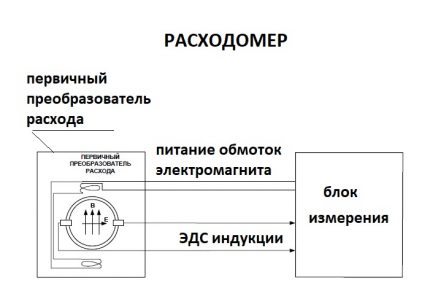
The measuring signal is taken by means of two electrodes, which are located diametrically and have contact with water. Mount counters in metal-plastic, metal, plastic pipes in the bathroom and toilet.
Ultrasonic variety of devices
These meters are universal, with their help they measure not only the flow of water, but also calculate the volume of gascouple. They, like electromechanical devices, cannot function without power supply, because they have an electronic calculating device, which without this is simply inoperative.
Measurements are made by the action of ultrasonic vibrations on the flow of water. The acoustic effect obtained as a result is analyzed by the sensor, and then the readings appear on the display.
Mount them both on the surface of the water pipe, and directly in it. If the installation is performed in the first way, the device can be quickly moved to another location for calibration of other meters or for temporary monitoring. Typically, such devices are used in industry.
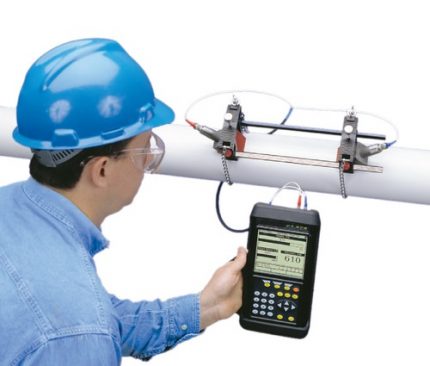
Ultrasonic water meters are characterized by low power consumption, which allows them to be used in many fields. The device is well protected from interference. The error in measuring with these instruments is a maximum of 1%.
In the design of such water flow meters there are no parts that can break, so they practically do not deteriorate. The latest models of such types of water meters as ultrasonic ones successfully combine good metrological qualities, accuracy and corresponding cost.
They are equipped with lithium batteries that retain their performance for more than 5 years. They also provide automatic adjustment at certain time intervals, which raises the measurement accuracy to a higher level.
The disadvantages of the equipment include the need for external power or autonomous. Also negative is the fact that the accuracy of the measurement is reduced due to the presence of air bubbles in the water.
Vortex water meters and their features
Vortex meters can work stably only if the water in the pipeline is clean and free of abrasive particles that can distort readings.
Each vortex counter incorporates a streamlined body. It is placed in a pipe and plays the role of an obstacle to the flow of water. Further downstream is a highly sensitive sensor. It responds to the smallest pressure fluctuations in the flow.
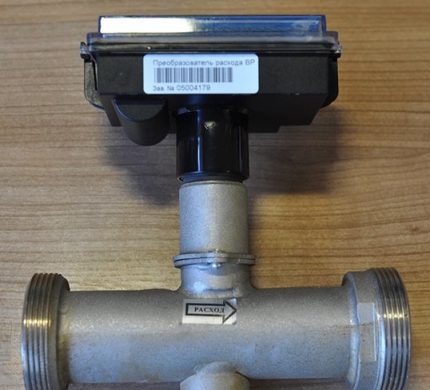
When the speed of a moving fluid reaches a certain value, vortices arise outside the obstacle. They are formed alternately from different sides and move with the flow. In this case, low and high pressure zones appear. This gives rise to a phenomenon called the “vortex track”.
Vortices appear with a frequency proportional to the speed of a moving stream. The distance between adjacent vortices corresponds to the volume of water flowing over the corresponding period. Therefore, the flow rate can be calculated by multiplying the number of vortices by volume. Vortices arise the more often, the greater the flow velocity.
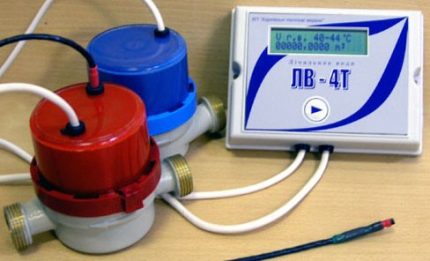
The average life of the device is 8 years. The main purpose is the regulation of technological processes. AT water distribution in the apartment to use such devices is irrational.
The meaning of the labels and symbols on the counters
Symbols and inscriptions on water meters can tell a lot about the device. Therefore, you need to learn how to decode them in order to find out those or other product features and determine which counter is suitable for specific conditions.
Manufacturers apply four basic designations to devices:
- Qmax - the maximum flow rate that does not cause errors in the operation of the device. The device can operate at this flow rate at a maximum of 1 hour. This must be followed by a break.
- Qn - optimal flow rate for the water meter. In relation to its maximum capacity, this parameter is 50% less. In the case when a volume of water equal to the normal flow rate passes through the body of the device, it will function without error. The device will be able to pass verification and will not have to be replaced with a new one for a long time.
- Qmin - the lowest flow rate, which when measuring the flow rate of water gives the smallest error.
- Qt - pressure at which the water-measuring device is unprofitable to operate, since it starts to work with a significant error. At the same time, it is difficult to predict with what sign the value of the error will be - it can be either a minus or a plus to the real readings.
In addition to these designations, the maximum temperature at which the device can function is applied to the body of the water meter.
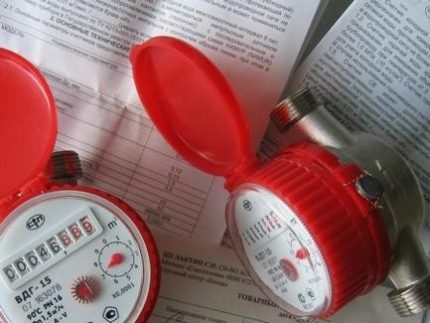
40 ° C is displayed on the cold water meters, and the body is blue. The casing of the flow meters for hot water is red or, which is much less common, black. Against this background, the inscription 90 ° C will be mandatory.
If water with a temperature exceeding 90 ° C is centrally supplied under pressure, you need to stop the selection on the meter with the inscription 150 ° C.
Flowmeter Tips
Knowing what water meters are on sale, when choosing, you need to decide in order to install a meter. If its installation is necessary in order to know how many cubes of cold water are consumed, expensive meters are not needed.
A simple “wet” tachometric version is quite suitable here, only you need to first agree on its class with the water supply company.
A tachometric water meter is also suitable for a pipeline with hot water, but in a “dry” design so that impurities in the water do not damage the measuring module. For a system where drastic changes are characteristic of the flow, it is better to choose a combination instrument.
The accuracy class of the counter is the higher, the smaller the permissible error. This parameter grows from "AND" before "D". Household appliances have an accuracy class "AT"if they are oriented to horizontal installation. For vertical installation, an “A” class is acceptable. Class "WITH" characteristic for electronic meters installed in any position.
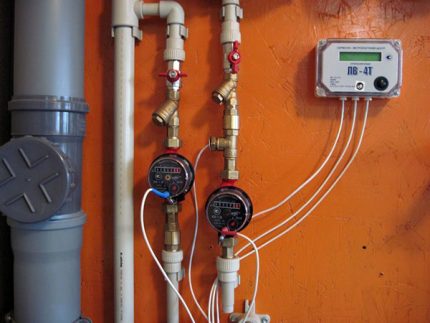
Consideration of the technical side when choosing a meter is required, but it is equally important to take into account the moment the device corresponds to the place where you want to install it.
If you need to hide the device in a niche, under the toilet or under the bath, then you should definitely consider what shape of the case "fits" into the free space. In one case, a device with a short body is suitable, in the other it is elongated in length.
Important when choosing and the orientation of the counter relative to the floor. It can be positioned vertically or horizontally. The main thing is that the data is easily read. If the device has a counting mechanism oriented horizontally, then the product itself should occupy this position.
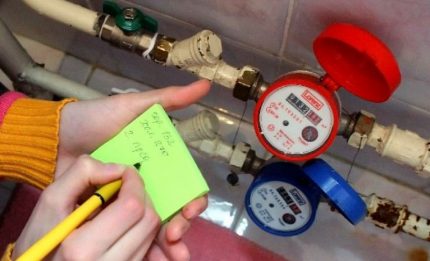
There are water meters in which the digital display is located so that it is possible to take readings only with its vertical installation. Since hot and cold water has different costs, payment is made on different accounts.
Top Counter Manufacturers
The market is rich in water meters, both domestic and foreign. From domestic manufacturers are considered the best:
- "Betar";
- "Economy";
- "Meter";
- Staroruspribor;
- "Triton".
The devices of these companies are cheaper than foreign ones and do a good job of their tasks. The main thing is that they are adapted to our realities to the maximum.
Among imported models, the greatest consumer confidence was won by:
- Zenner (Germany);
- Wehrle (Germany);
- Actaris (France);
- Viterra (Germany);
- Siemens (Germany).
They have a large calibration interval, traditionally high reliability. We must not forget the fact that they are designed for water of higher quality than that which flows in our pipelines.
Therefore, you need to be prepared for breakdowns, so it does not hurt to find out if there are service centers nearby.
Conclusions and useful video on the topic
Video # 1. Why are counters and their main types needed:
Video # 2. Brands of water meters. Which device is better:
The purchase of a water meter is an additional expense item, but it is justified. Spent soon will not only pay off, but will also save considerable amounts on water charges.
Most importantly, purchase water meters manufactured by a trusted manufacturer.A cheap water meter of poor quality, as a rule, has a large error and you will have to pay too much.
Want to talk about how to choose a water meter for your own apartment? Share which model you are staying on and why. Please leave comments, ask questions and post a photo on the topic of the article in the block below.

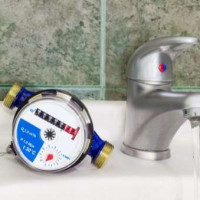 Verification period for cold and hot water meters: verification intervals and rules for their implementation
Verification period for cold and hot water meters: verification intervals and rules for their implementation 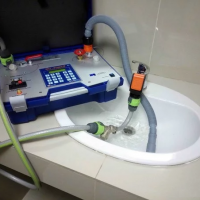 Verification of water meters at home without removal: the timing and subtleties of verification
Verification of water meters at home without removal: the timing and subtleties of verification 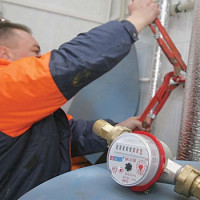 The order and rules for installing water meters: installation and sealing rules
The order and rules for installing water meters: installation and sealing rules 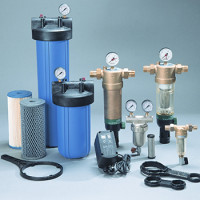 Filters for rough and fine water purification: overview of types + installation and connection rules
Filters for rough and fine water purification: overview of types + installation and connection rules 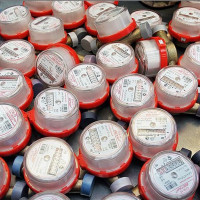 Rating of the best cold and hot water meters for an apartment: a dozen models + nuances of the choice of flow meters
Rating of the best cold and hot water meters for an apartment: a dozen models + nuances of the choice of flow meters 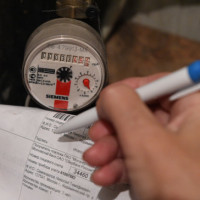 Water meter readings: an algorithm for taking readings and transmitting them to regulatory authorities
Water meter readings: an algorithm for taking readings and transmitting them to regulatory authorities 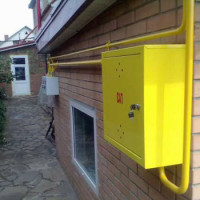 How much does it cost to connect gas to a private house: the price of organizing gas supply
How much does it cost to connect gas to a private house: the price of organizing gas supply 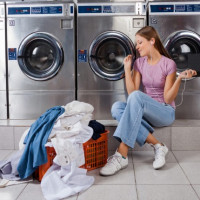 The best washing machines with dryer: model rating and customer tips
The best washing machines with dryer: model rating and customer tips 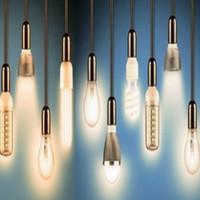 What is the color temperature of light and the nuances of choosing the temperature of the lamps to suit your needs
What is the color temperature of light and the nuances of choosing the temperature of the lamps to suit your needs 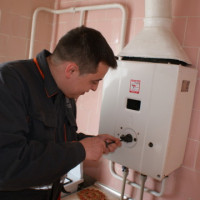 Replacement of a geyser in an apartment: replacement paperwork + basic norms and requirements
Replacement of a geyser in an apartment: replacement paperwork + basic norms and requirements
In my opinion, the problem is not so serious. For an apartment or a residential building, you can and should choose the simplest tachometer counters. They are very inexpensive, the installation is simple, you can do it yourself. The main thing is to look at the arrow, which indicates the direction of water flow. Well, a check valve filter is a must. And that’s it! Simple and working design. And everything else is from the evil one. Well, who would explain to me: why put an electromagnetic or vortex, ultrasonic meter in an apartment, if they also give electricity? Is it practical? Of course not.
Is an electromagnetic meter difficult to install? So far I am only eyeing this kind of counters, but have not yet decided on the model. Does it make sense to buy a counter more expensive from a well-known foreign manufacturer, or one that is cheaper will also serve the norms? It’s just that the prices are different, maybe someone is some inexpensive, but he will advise a quality option.
Do you need it? No seriously. If you take the electromagnetic, then there on the drum - ours or imported. Thank God the simplest technique and we have learned to collect quality. He just has a lot of stocks. Firstly expensive, secondly it requires electricity. In general, the light will be cut down, you will remain without water. Do you need accuracy? Take you tachometric dry meter and do not worry.
Hello. Please see the corresponding article on the site - https://engineeris.decorexpro.com/en/vodosnab/filtr-schet/luchshie-schetchiki-xolodnoj-i-goryachej-vody.html
For several years, there have been hot and cold water meters in the apartment. There are tachometric counters. The first flowmeters lasted five years and were replaced with new ones a year ago. As I understand it, such counters can last much longer. However, the water flows through the pipes is very hard and contains various impurities. And I always observe the schedule for checking meters, I do not postpone it.